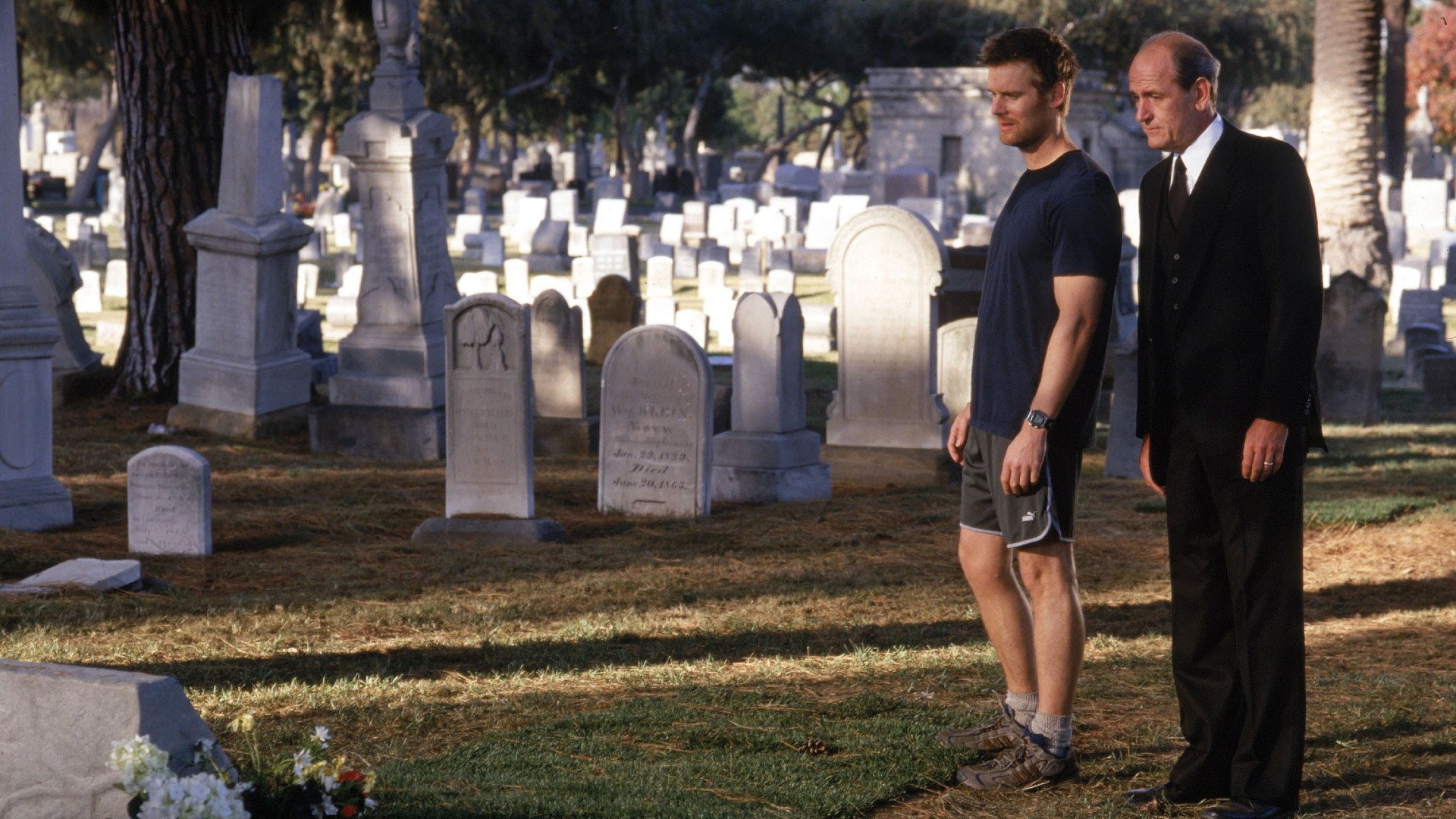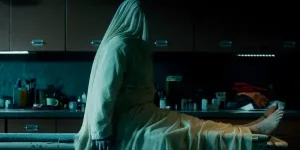
This article contains spoilers for the Six Feet Under series finale.
Every episode of Six Feet Under begins with an ending.
While not as well-regarded as its early 2000s HBO drama brethren The Sopranos and The Wire, Six Feet Under is still an important part of HBO, and therefore television, history. It’s also very good, as Netflix subscribers can now find out thanks to Warner Bros. Discovery’s content-sharing initiative with the streamer. (Previous HBO titles moving to Netflix include Band of Brothers and Ballers).
Created by Alan Ball (True Blood), Six Feet Under premiered on June 3, 2001 and followed the Fisher family as they tried to keep the family business of Fisher & Sons Funeral Home together after the death of paterfamilias Nate Sr. (Richard Jenkins). Naturally for a show set in a funeral home, the opening minutes of each Six Feet Under installment features a death that will produce a corpse for the Fisher family to prep for burial, starting with Nate Sr. himself and continuing on through five more seasons of anonymous stiffs.
Even as its characters went through the familiar domestic drama of their day-to-day lives, Six Feet Under was always thinking about endings, more specifically the ending that everyone universally experiences: death. That’s a major aspect of what what the show special in the first place. Though death was a capitalistic engine for the Fisher family to keep the lights on and their bills paid, it was also a little talked about specter that floated all around them. If there were ever a series to make a grand show of its series finale, it was this one. And that’s exactly what it did. So let’s talk about that ending and what the rest of the TV landscape can learn from it all these years later.
The “ending” of Six Feet Under actually begins a few episodes before the finale. In season 5 episode 9 “Ecotone,” lead character Nate Fisher Jr. (Peter Krause) dies after experiencing a massive stroke. Nate’s death is an absolutely unmooring experience for the Fisher family, despite the fact that A. they knew his health was at risk due to an arteriovenous malformation (AVM) in his brain. B. they had already experienced the unexpected death of someone named Nate Fisher in the pilot, and C. they’re literally in the business of death and know it rarely arrives according to you schedule.
Nate both literally and figuratively haunts his living family members through the final three episodes of the series. His mother Ruth (Frances Conroy) continuously weeps and hallucinates. His little brother (Michael C. Hall) has multiple panic attacks upon facing the reality of suddenly being his family’s keeper. His little sister Claire (Lauren Ambrose) can’t bear to see his body. The Fishers weren’t prepared and there was never a circumstance in which they would have been.
“The message is that we die,” Ball told New York Mag about the timing of Nate’s death in 2005. “And sometimes we die in the middle of messy things in our lives. Death doesn’t wait until you take care of all your issues.”
Still by the time the finale, “Everyone’s Waiting” rolls around, the Fisher family has made great progress in taking care of at least some of its issues. That episode, which opens not with a death but with the birth of Nate’s daughter Willa Fisher Chenowith, finds Fisher & Sons (and daughter) settling their affairs in a very “TV finale” kind of way. Ruth and Claire share a touching conversation in which Ruth encourages her daughter to move to New York to pursue a professional opportunity, assuring her that she’ll be OK even after the death of her eldest son. David and his husband Keith (Matthew St. Patrick) make the decision to buy out the funeral home’s business partner Rico Diaz (Freddy Rodriguez) and run the family business the way Nate Sr. always wanted.
The characters’ progress throughout roughly 90% of “Everyone’s Waiting” makes for a very satisfying narrative ending. But, as Six Feet Under deeply understands, there’s really only one ending when it comes to human lives. So it goes ahead and shows us that too.
Yes, the real ending of Six Feet Under is a montage featuring the eventual death of every single character. As a tearful Claire drives away to her new life in New York, listening to Sia’s “Breathe Me,” the show flashes forward to everyone’s final moments. You can watch the whole thing here: (NOTE: The video is cut into two parts and the sparse dialogue is in French but that’s just the price to pay for a good YouTube embed opportunity).
Ruth O’Connor Fisher dies in a hospital bed in 2025, surrounded by her living family members and the ghosts of her first husband and oldest son. Keith Dwayne Charles is shot to death in 2029 during an armored van robbery. An elderly David James Fisher keels over on a sunny day in the park in 2044 after seeing the spitting image of his dead husband in the face of one of their sons. Hector Frederico Diaz experiences a fatal heart attack on a cruise ship in 2049. Nate’s wife Brenda Chenowith (Rachel Griffiths) keels over while her annoying brother Billy (Jeremy Sisto) chats her ear off in 2051. Claire lasts all the way until 2085 before peacefully passing away in bed at the age of 102 years old.
It’s a striking, beautiful, unnerving conclusion that never gets old regardless of how many times you watch it – even if you’ve never even seen the show. It’s also just so damn logical. As Ball would later reveal in a 2016 HBO interview, once the writers’ room came up with the idea, they knew it was the only way to end the series: “Somebody said ‘we should just kill everybody. We should flash forward in time and see each character as they die.’ I just sort of went…’duh, that’s EXACTLY how this show should end.’”
So, what exactly, can other TV dramas learn from Six Feet Under‘s ending? It’s not like every other episodic endeavor is death-centric and therefore must end in every character’s death. I’ll admit that the original conception for this piece was to encourage other TV shows to do literally that. The headline “Every Show Should End Like Six Feet Under” was an actual (tongue-in-cheek) command. I imagined a world in which The Office series finale flashed forward to Michael Scott dying in a tragic 2021 waffle iron accident or the Mad Men series finale flashed forward to Don Draper’s death from lung cancer in 1989.
But as I sit here moved from watching the Six Feet Under ending for the umpteenth time, something more constructive comes to mind. The real lesson for any television show to take away from Six Feet Under‘s perfect conclusion is to “know thyself.” The Six Feet Under ending works conceptually, emotionally, and creatively. Any drama hoping to craft something similar with have to make sure their ending does as well.
In that sense, the series finale closest to Six Feet Under in terms of success might ironically be The Sopranos‘ non-ending. While Six Feet Under‘s final moments are exhaustively conclusive, The Sopranos‘ are deliberately vague. And yet, they both work because they honor what came before it. Death was a constant companion for Six Feet Under just as sin and confusion were for its HBO drama companion.
Having said all that though, if you ever want to get a sense of what another TV series ending like Six Feet Under would look like, then you’re in luck. As always … The Simpsons already did it.
All five seasons of Six Feet Under are now available to stream on Netflix.
The post Every TV Show Should End Like Six Feet Under appeared first on Den of Geek.






